Who doesn’t love a road trip? And it isn’t a family trip if our favorite canine doesn’t come along. But how many people properly secure their dogs in car seats or harnesses for those trips? (Hands up, now – be honest) If you don’t, not only is your dog at risk of injury, so are YOU. Luckily, pet lovers inhabit every field, including engineering. That means devoted dog lovers are working to develop, test, and provide quality dog car seats and restraints to keep your furry family members safe.
Dogs and Cars
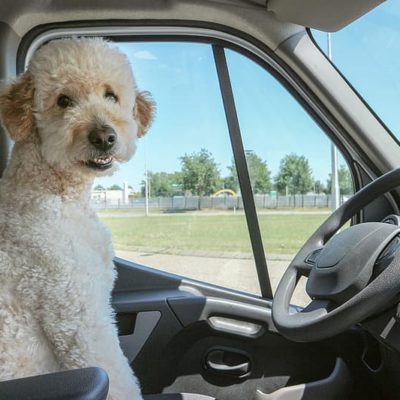
People have always loved taking their favorite pooches on adventures. And when vehicles started hitting the road, so did our furry friends. But dog car seats weren’t around until 1932. And they weren’t the more impressive safety features in the world.
The Bird-Dog’s Palace gets credit as the first dog car seat. It looked like a crate, and people used it for pets of every shape and size. Not the most comfortable thing in the world, but it at least provided SOME restraint.
In 1936, they improved on their design with a cloth sack. Dogs felt comfy. However, in collisions, the car seat proved useless. Owners found their dogs suffering injuries.
Marie French undertook the challenge of the dog car seat in 1957. She designed an entire pet trailer you could attach to the back of your car (similar to a bike trailer). Your dog got plenty of room to move around, as well as compartments for their food and water bowls. But you didn’t get direct sight of them. And you needed to check all of those connection points.
But it shows you how much people have thought about traveling with their dogs in cars!
Dog Car Seat Safety
The National Highway Traffic Safety Association (NHTSA) reports 50% of all fatal accidents result from distracted driving. (50%!) And we can’t blame all of those accidents on cell phones. Nope, it turns out 25% of owners admit to holding their pets while braking. A further 19% confess to fending a pet away from the front of the car. So pets roaming the car is a HUGE distraction.
A 2013 study found owners driving with their pets were MORE LIKELY to get into an accident. Focusing on your dog takes your eyes off the road, and you might even take your hands off the wheel. New Jersey, at least, decided enough was enough. In 2011, the state amended its anti-cruelty law, making it a violation to drive with an unrestrained animal in the car. Suddenly, a demand arose for quality dog car seats. Into that need stepped Lindsey Wolko.
A poorly designed restraint injured Lindsey’s dog. Deciding she wanted better for other animals, she founded the Center for Pet Safety (CPS). Using the same standards Federal Motor Vehicles use for children, the CPS began testing the available pet restraints on the market. Every single one FAILED. Yup, it was time for a change.
Choosing a Car Seat for Your Dog
Dog car seats and restraints have improved. The CPS now certifies products. (When safety’s on the line, pet owners have a way of getting results). However, there are hundreds of car seats on the market. How to choose the right one?
A good dog car seat absorbs the energy in an accident and controls possible rotation. The dog should stay in place and not accelerate forward. But you still need to do a little homework. Here are some important notes:
- Size: Car seats, in particular, are rated for specific sizes. If a seat is too small, your dog won’t stay inside. Too large? They’ll slide around, and you lose effective restraint. So look at those weight restrictions.
- Method of Securing: Not every car seat attaches the same. Some need a headrest while others don’t. Does your car have a headrest in the backseat? Some require a shoulder strap. Look at the instructions for proper installation to make sure your vehicle will accommodate the seat.
- Ease of Use: How simple is the car seat to use? If it’s going to take you an hour to get that dog car seat into place, are you going to use it? Probably not. Practice makes perfect, but be honest with yourself on what you’re willing to tolerate.
- Storage: Many seats collapse for easy storage. Other seats are bulkier and won’t remain out of the way. Again, you need to decide what will work for you.
- Cleaning: Take a look at the car seat’s materials. Can the cover be removed for cleaning? While car seats generally help with carsickness, nothing is guaranteed. Also, if you allow your dog outside on the trip, how dirty will they get? Are you willing to put up with that smell in your car? A good car seat allows for regular cleaning.
Using Dog Car Seats
While dog car seats come designed for safety, you still need to take precautions. In an accident, the potential for harm exists if you don’t observe basic rules:
- Don’t attach your dog’s leash to restraints – use their harness. Leashes become choking hazards, or they can cause neck injuries. This is also why you should use harnesses and not collars. Think about yourself in an accident – do you want something around your neck? Of course not.
- Always use the provided tethers. You may have the best-behaved dog on the planet. But in an accident, that tether will keep your pup safely within their dog car seat. You don’t want to take any risks.
- Introduce new car seats or restraints slowly. Start OUTSIDE of the car first. You don’t want to feel anxious and take your eyes off the road to check on your dog. Better to delay a trip while your dog learns to trust the car seat than cause an accident.
- NEVER use the front seat for your dog’s car seat! The airbag is a genuine threat to your dog. Even if a car seat says it can go in the front seat, don’t do it. Your dog’s body CAN’T absorb the impact of the airbag. You can see your dog in the rearview mirror, and he can see you. You DON’T need to be beside each other.
- No dogs can stay unattended in the car. The inside of a car is NEVER the same temperature as the outdoors. During the summer, it takes only a few minutes for a dog to succumb to heatstroke!
Best Dog Car Seats
Whether you want to take a day trip to a friend’s house, plan a family vacation, or head to that vet appointment, your dog shouldn’t remain loose in the car. At 50mph, a 10-pound dog can turn into a projectile with 500 pounds of force! And we’re not picking on the small dogs, either. At a measly 30mph, an 80-pound dog turns into a 2,400-pound projectile! The damage they can do to you and themselves is staggering.
This is why dog car seats are so important – for EVERY size of dog. The time it takes to secure your pup into a restraint is worth it. They’ll remain happier and healthier.
Booster-Style Dog Car Seats
A booster seat provides an advantage for smaller dogs – namely, the chance to look out the window. Such dog car seats add around ten extra inches of height. Looking out the window helps calm anxiety, provides entertainment, and eases carsickness – something important for many owners. They’re not miracles, though. So you may want to keep a stash of puppy pads handy, just in case.
Large dog car seats aren’t easy to come by. But A4 provides an option sized enough to hold Labradors or Goldens. The comfortable base provides 6.5 inches of extra height to give your pup a view out the window. And the two-sided cover allows you to change things up depending on the season: fleece for the cold and Oxford linen for when it’s warm. Double security tethers connect to the harness. And when you’re done with the car seat? You can fold it out of the way and tuck it into the carry case.
Downsides? This dog car seat works well for the bigger canine set, but it’s TOO LARGE for tiny pups. You will also need a headrest on your backseat for proper security. And while you get the two tethers, they’re not the strongest. You CAN replace them, but they’ll mean an extra cost.
The Good
- Washable and collapsible
- Two front pockets
- Carrying case
The Bad
- Too large for small dogs
- Need a headrest for proper installation
- Tethers not strong enough
Devoted Doggy provides your little pup with an unobstructed view out the window. The steel frame is easy to assemble, and it collapses flat when you don’t need it. But the plush liner is comfortable for your dog to sit in (and a cinch to toss into the washing machine). The safety tethers clip to the seat belt, providing an extra level of security. And you get a handy pocket on the side for any extras you want to keep close during the trip.
The downsides? The packaging says dogs can weigh up to 20 pounds. However, people have found you need to go a bit lower – more like 15 pounds – to keep your pup comfortable. You definitely need a headrest for installation. And with how high the dog car seat sits, you’ll probably need to lift your dog inside.
The Good
- Washable and collapsible
- Zippered front pocket
- Safety tether connects to seatbelt
The Bad
- Dogs must weigh less than 15 pounds
- Need a headrest for proper installation
- Sits high
K&H has an excellent reputation in the pet world. The Bucket Booster is durable enough to handle even exuberant dogs. A 3-inch cushion provides extra comfort, and the interior has a fleece covering for warmth in the winter and cooling in the summer. The cushion and cover come off and are washable. Two adjustable leashes attach to your dog’s harness to keep him secure and safe. The Bucket Booster comes in two sizes.
So what are the downsides? It’s pretty bulky. It isn’t the most expensive option out there, but it also isn’t the cheapest. People also found the cushion coming loose during longer rides.
The Good
- Washable
- Two adjustable leashes
- 3-inch cushion and fleece covering
The Bad
- Bulky to place in the car
- Cushion comes loose
The Kurgo Skybox is a dream come true for people looking for convenience. This dog car seat is entirely collapsible! Constructed from ripstop material, it’s not only durable but easy to clean. The microsuede cover and removable pillow are washable. Best of all? It has two zippered pockets! This car seat comes with a lifetime warranty – not something you see a lot! Your dog’s harness attaches to the car’s seatbelt rather than the Skybox.
Downsides? Your dog needs to weigh 20 pounds or less. While it claims to fit 30 pounds, reviewers state otherwise. A headrest is mandatory for installation. Also, the sides are quite high, so some people feel it isn’t very comfortable for their dogs.
The Good
- Washable and collapsible
- Comes with zippered pockets
- Lifetime warranty
The Bad
- Dogs must weigh less than 20 pounds
- Need a headrest for proper installation
Maybe you have two dogs you need to take on trips with you. Or perhaps you need a large dog car seat. That’s where Petsfit comes in. Their extra-wide option can support up to 45 pounds. This provides plenty of room while the two safety tethers offer the security you need. You have a reversible cover to keep your pup warm or cool, as the weather dictates (washable, of course). And you even have two color options to choose from!
The downsides? You will need TWO of the back seats to accommodate this dog car seat, as well as the headrest. And people found installation difficult as the instructions aren’t clear. This is also another case where the safety tethers weren’t very strong – something of a concern when you have larger dogs going into the seat.
The Good
- Washable and collapsible
- Available in 2 colors
- Reversible liner
The Bad
- Dogs must weigh less than 45 pounds
- Need two back seats and a headrest for proper installation
- Tethers not strong enough
Carrier-Style Dog Car Seats
A dog car seat is a significant investment. Worth it? Absolutely. But still a big investment. Some people elect to justify the cost by purchasing car seats that double as carriers. If your dog doesn’t get carsick, isn’t claustrophobic, and isn’t very large, this is a great option. (Large dog car seats are tricky to find)
Sleepypod is one of the pet companies that’s gone out of their way to gain CPS certification. And the Air is a popular choice of carrier that works any time you need to make a trip. The bucket-style is super cozy, with plenty of mesh windows to provide ventilation. It comes with two openings to help you get your dog in or out of the carrier, and you have your choice of handles or a shoulder strap. It’s easy to secure with a seatbelt, and there’s a safety tether inside.
Downsides? This is one of the more expensive dog car seats out there. (Of course, it does double as a carrier) Dogs also need to weigh less than 15 pounds to fit inside.
The Good
- CPS certified
- Water-resistant liner
- Also rated for air travel
The Bad
- Expensive
- Dogs must weigh less than 15 pounds
As you might guess, Sleepypod’s Mobile Pet Bed has CPS certification, too. Constructed from luggage-grade nylon and polyester, it has a convenient shoulder strap to help you and your dog on your travels. The mesh dome provides constant airflow, and there’s a water-resistant liner. Even better? This particular carrier doubles for air flight! For car travel, secure the base with the seatbelt and pass the shoulder belt through the handle.
Downsides? The Sleepypod only works for dogs under 15 pounds. It’s also on the pricey side.
The Good
- CPS certified
- Water-resistant liner
- Also rated for air travel
The Bad
- Expensive
- Dogs must weigh less than 15 pounds
Pet Gear knows you need flexibility with your dog car seat. So they provide an easy carrier with plenty of mesh windows for your dog to keep an eye on things. The carry handles allow you to pick things up when you reach your destination, while the safety tether keeps your pup secure inside. And the removable fleece cushion is a cinch to wash.
So what are the downsides? You won’t find a shoulder strap, which can make transportation difficult for some people. The handles are how you secure the carrier to the seat, and they’re not the most reliable. You’re also going to find a max weight of around 25 pounds.
The Good
- Nylon shell
- Washable fleece cushion
The Bad
- Dogs must weigh less than 25 pounds
- No shoulder strap
- Handles don't secure in car well
WOPET has a comfortable interior for your dog to snuggle up inside. The adjustable straps on the outside make the carrier easy for you to manage. Even better, there are exterior pockets on the sides! (Seriously, who doesn’t love pockets?) A clip inside attaches to your dog’s harness to keep them from escaping the carrier. The outside nylon shell is waterproof AND resists dog hair. This carrier also works for airline travel.
Downside? Again, it’s only for dogs under 15 pounds.
The Good
- Exterior pockets
- Adjustable straps
- Nylon shell waterproof and repels pet hair
The Bad
- Dogs must weigh under 15 pounds
Car Harnesses
What do we do about larger dogs? Obviously, we’re not going to plunk a Great Dane into a booster seat. (Please don’t try) We still want to keep those dogs safe, though. Unrestrained animals often run away from accident sites. You don’t want that to happen. That means finding a proper restraint for your bigger dog. And when you can’t use large dog car seats, car harnesses do the trick.
Kurgo received crash test approval for dogs weighing up to 75 pounds. The padded chest plate remains comfortable, no matter what position your dog takes. You then use the clips at the lap, shoulder, and back to secure your pup to the seatbelt. And when you need to take a break on the drive (or around the house), the harness works for stretching those puppy legs.
Downsides? This won’t work well for deep-chested dogs. And people saw some issues with wear-and-tear on the straps.
The Good
- Crash-tested for up to 75 pounds
- Dogs can comfortably sit or lie down
- Doubles as a walking harness
The Bad
- Not designed for deep-chested dogs
- Straps not durable
The Load Up Harness is another harness that works in and out of the car. It’s easy to fit your dog, and it attaches through the seatbelt. The Load Up passed CPS certification in the small and medium sizes, but the larger sizes allowed dogs to contact the front seats. For this reason, certification got denied. However, it’s still worth keeping in mind.
The downsides? The price – they’re expensive. They also don’t work with deep-chested dogs (these dogs are difficult to work with – they have a funny shape).
The Good
- CPS certified for small and medium sizes
- Works in and out of the car
- Durable
The Bad
- Expensive
- Not designed for deep-chested dogs
Sleepypod again? Yup, and for the same reason – CPS certification. The Clickit Sport is a vest-style harness with a three-point design. In case of an accident, the movement gets minimized, and force is distributed evenly throughout the torso. A seatbelt is secured through the straps, allowing your dog to sit or lie down as usual. It’s made from ballistic nylon, giving it a long lifespan, and you can also use it as a walking harness.
So what are the downsides? It doesn’t work with deep-chested dogs (like Greyhounds – boo). It’s also a little pricey.
The Good
- CPS certified
- Dogs can comfortably sit or lie down
- Doubles as a walking harness
The Bad
- Expensive
- Not designed for deep-chested dogs
Keeping Your Dog Safe in the Car
Let’s face it – cars are dangerous objects. We need to do everything we can to keep ourselves and all of our passengers safe. That means getting a dog car seat, carrier, or harness and using it EVERY time.
Roads and cars are dangerous. Dog car seats make both a safer place – for everyone.

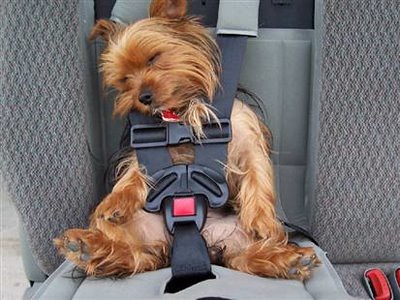
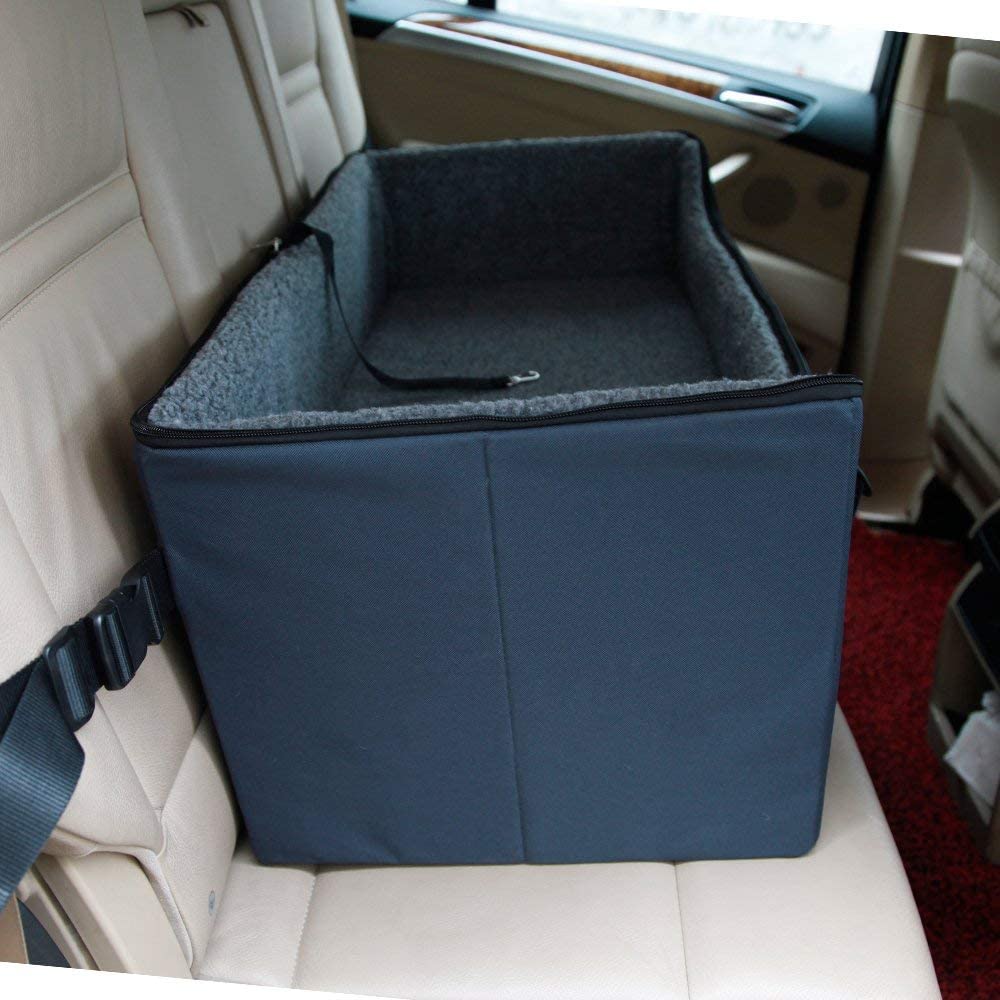
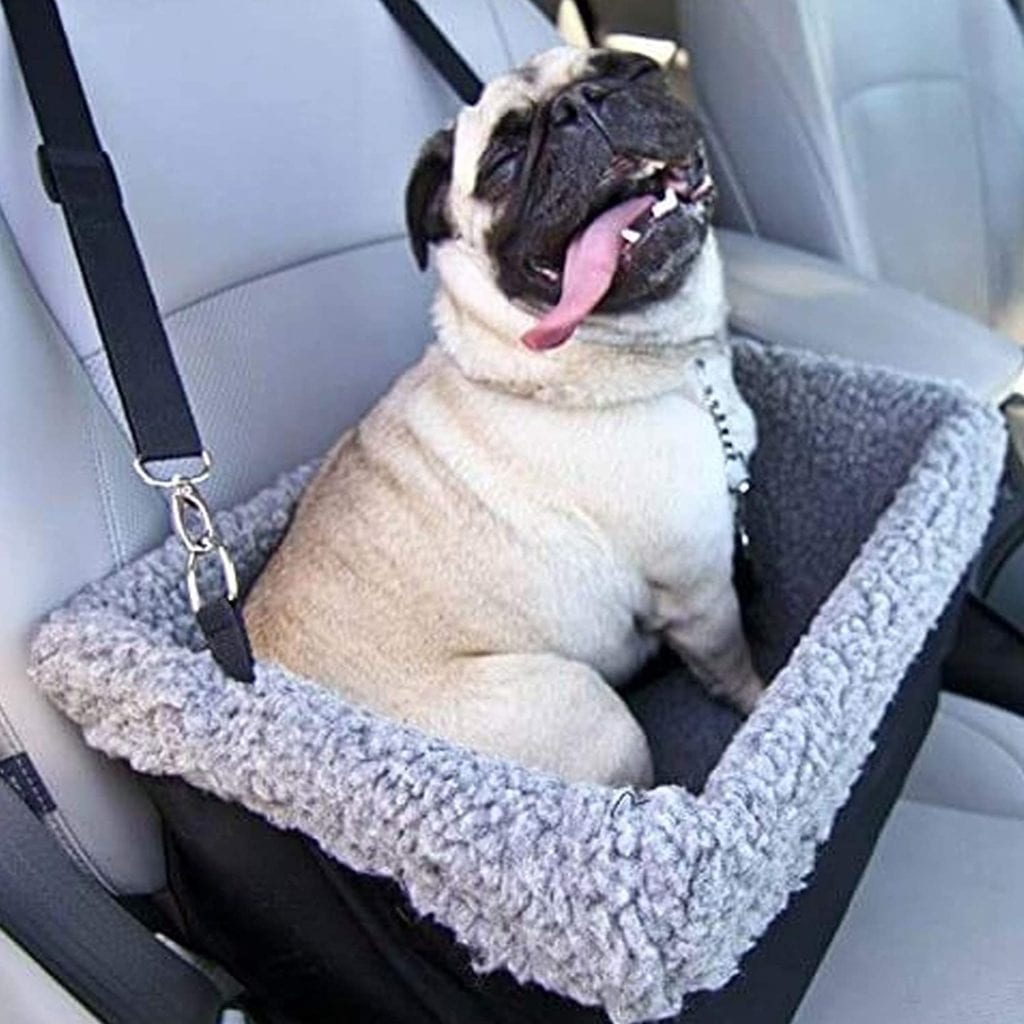
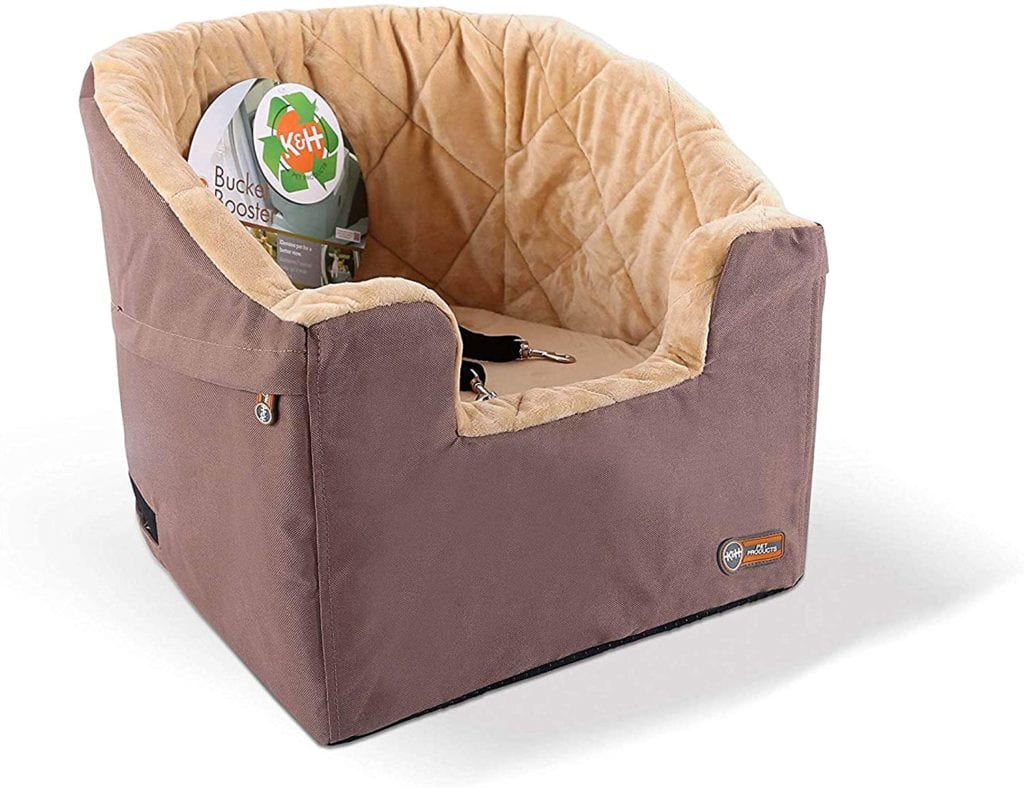
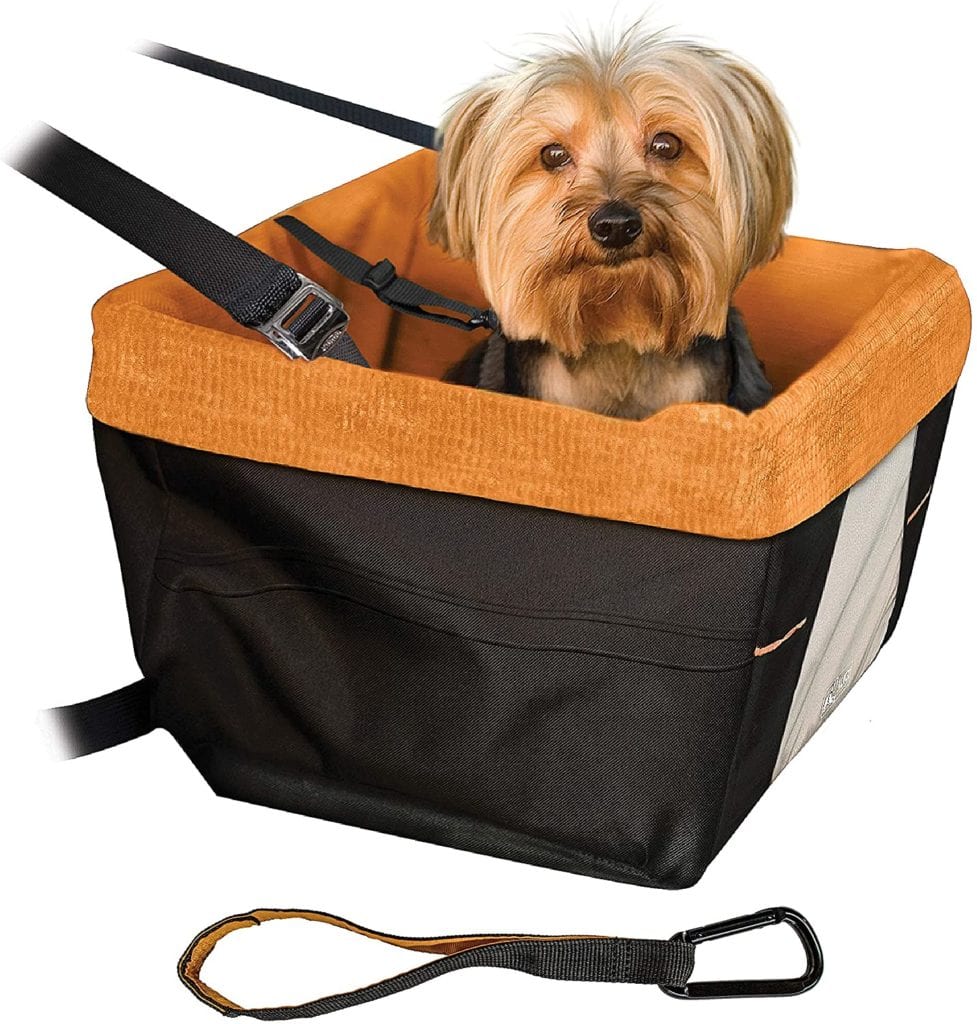
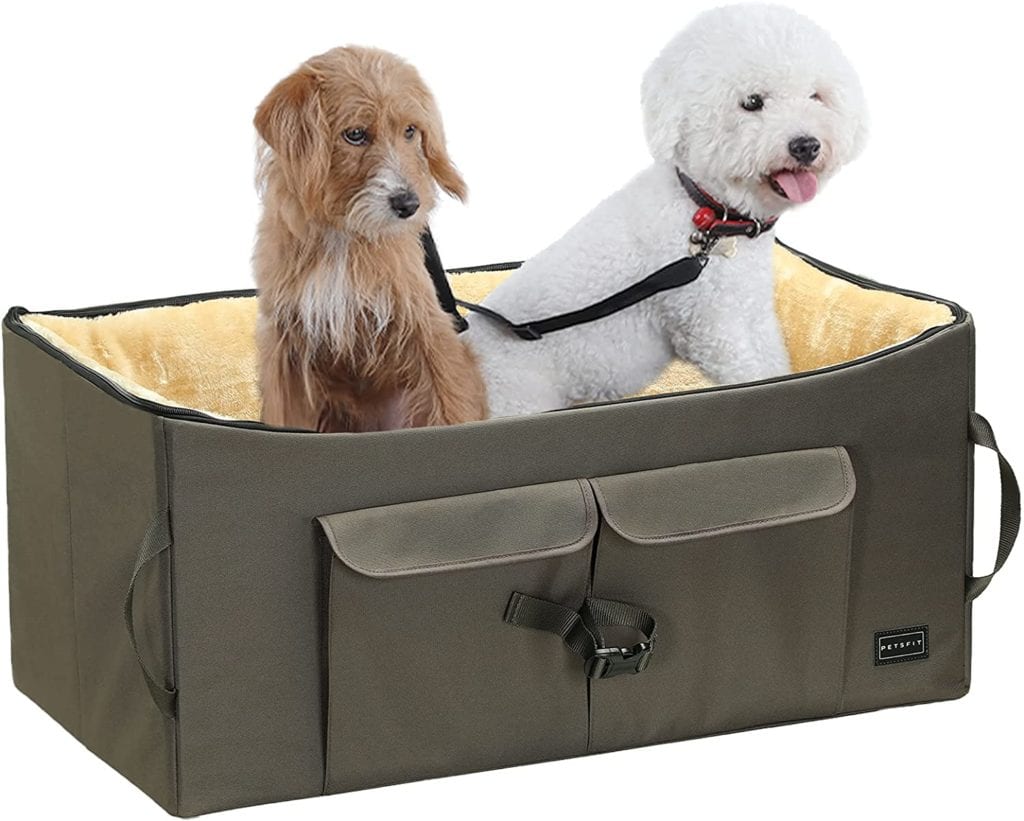
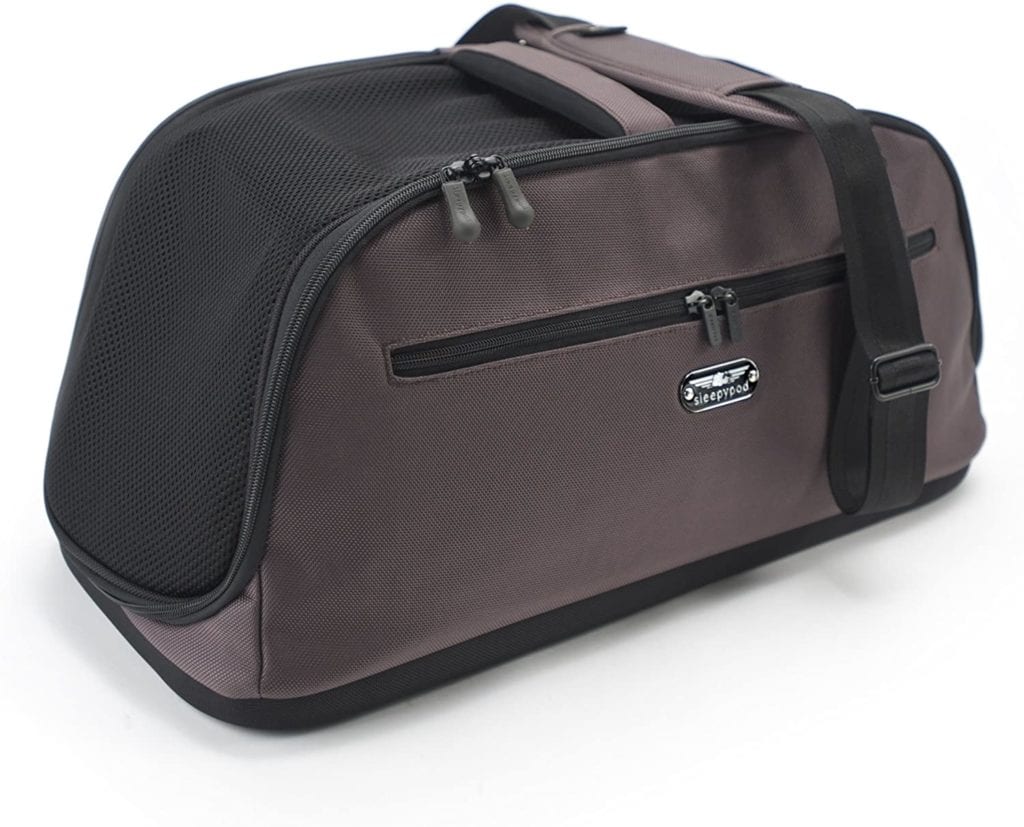
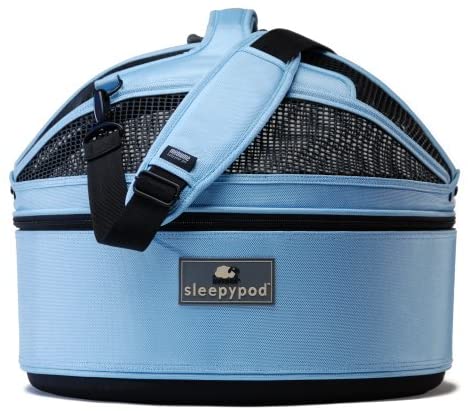
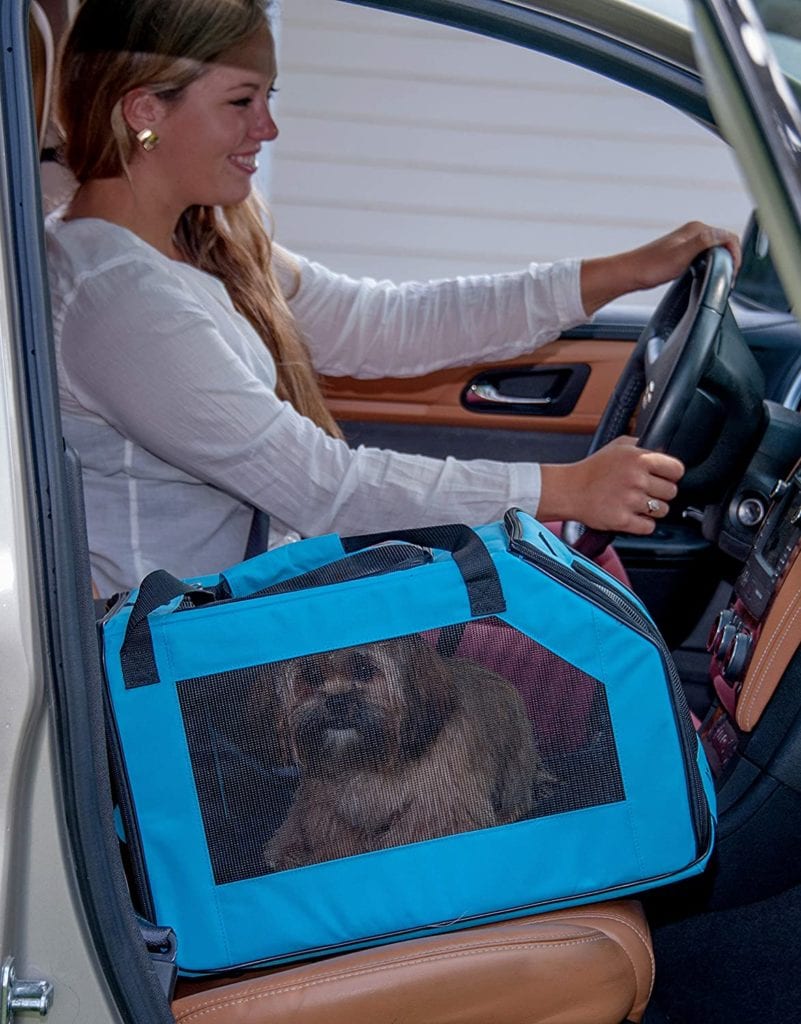
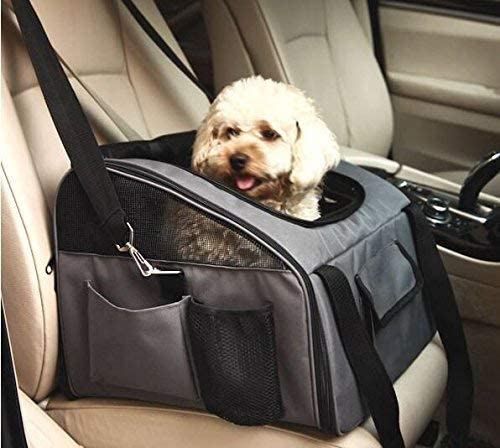
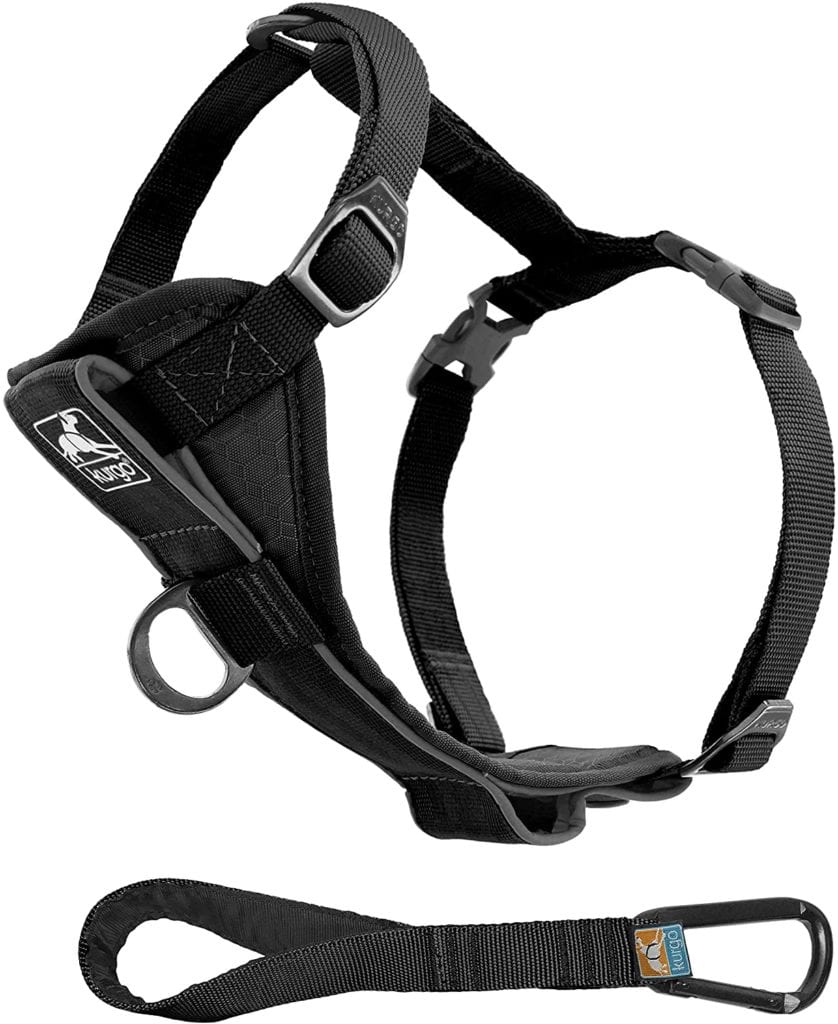
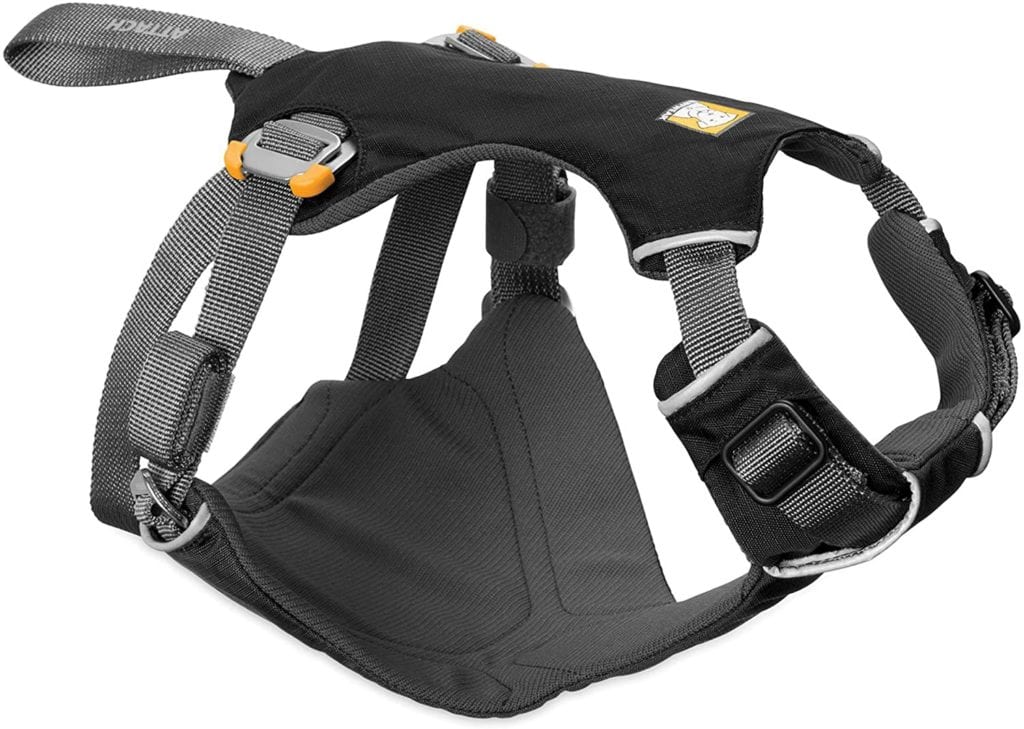
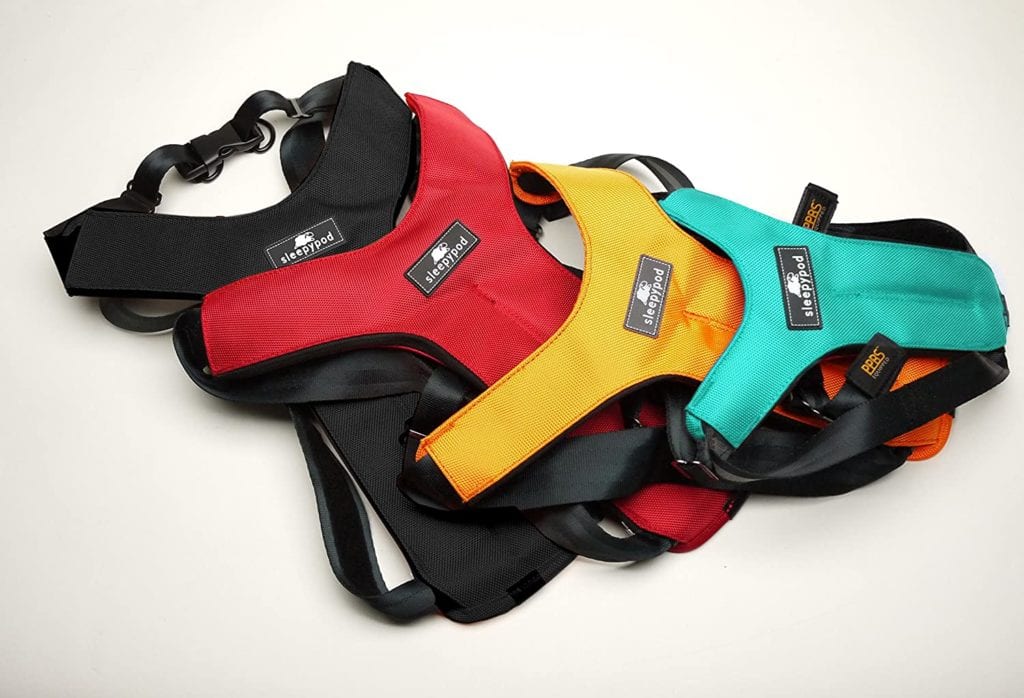



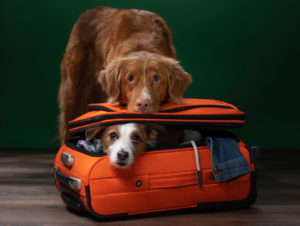
2 Comments
I HAVE A QUESTION ABOUT THE ZUGOPET ROCKETEER PACK MULTIFUNCTIONAL HARNESS. ITS CPS CERTIFIED. IS IT WORTH IT?
Our list above is not completely exhaustive, but if the car seat is CPS certified it is probably a good bet for safety!